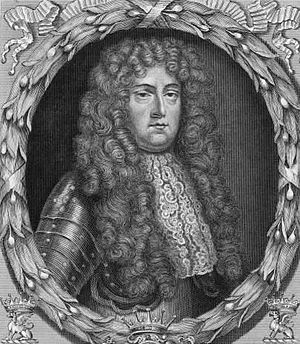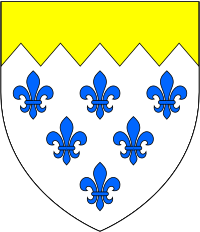Robert Paston, 1st Earl of Yarmouth facts for kids
Quick facts for kids
The Right Honourable
The Earl of Yarmouth
|
|
|---|---|

The Earl of Yarmouth, by Burnet Reading
|
|
| Member of the England Parliament for Castle Rising |
|
| In office 1661–1673 Serving with
|
|
| Preceded by |
|
| Succeeded by | |
| Member of the England Parliament for Thetford |
|
| In office 1660–1661 Serving with Sir Philip Wodehouse
|
|
| Preceded by |
|
| Succeeded by |
|
| Personal details | |
| Born |
Robert Paston
3 May 1631 |
| Died | 8 March 1683 (aged 51) |
| Spouse |
Rebecca Clayton
(m. 1650) |
| Children | 9, including William Paston, 2nd Earl of Yarmouth |
| Parents |
|
| Residences | Richmond, London, England |
Robert Paston, 1st Earl of Yarmouth (born May 29, 1631 – died March 8, 1683) was an English scientist and politician. He was a member of the House of Commons from 1660 to 1673. Later, he was given the titles of Viscount Yarmouth and then Earl of Yarmouth. He was also a Fellow of the Royal Society, a group for important scientists.
Contents
Robert Paston's Early Life and Education
Robert Paston was the son of Sir William Paston, who was a baronet from Oxnead. His mother was Lady Katherine Bertie. Robert went to Westminster School and then studied at Trinity College, Cambridge in 1646. After his studies, he traveled to France.
Becoming a Member of Parliament
In 1660, Robert Paston was chosen to be a Member of Parliament (MP) for Thetford. This was during a special meeting of Parliament called the Convention Parliament. Soon after, he was knighted on May 27, 1660.
In 1661, Paston became an MP for Castle Rising. He held this position until 1673. At that time, he was given the title of Viscount Yarmouth, which meant he had to leave his seat in the House of Commons. When his father died in 1663, Robert also inherited the title of baronet.
Important Roles and Titles
On March 6, 1676, Robert Paston was made Lord Lieutenant of Norfolk. This was an important role representing the king in Norfolk. He kept this job until he died. In 1679, he received an even higher title, becoming the 1st Earl of Yarmouth.
Robert Paston and Science
Robert Paston was interested in science. When the Royal Society was created in 1660, he became one of its first members on May 20, 1663. The Royal Society is a famous group for scientists.
Experiments with Alchemy
Paston worked with another scientist, Thomas Henshaw. They tried to find a special formula called the "red elixir." This was another name for the philosopher's stone. Alchemists believed this stone could turn regular metals into gold.
Paston even wrote a letter to Sir Thomas Browne, a doctor and philosopher. In his letter, he talked about his experiments. He mentioned seeing a "salt" change color and believed he was close to finding something amazing. He thought he had found a way to "dissolve gold as warm water doth ice."
Life in Richmond and Cricket
Robert Paston lived in Richmond. In May 1666, he wrote a letter to his wife. In this letter, he mentioned "a game of criquett on Richmond Green." This is the first known time that the game of cricket was mentioned in connection with Richmond Green.
There is a painting at the Norwich Castle Museum that shows Robert Paston. It also shows his father William's collection of valuable items, known as The Paston Treasure.
Robert Paston's Family
Robert Paston married Rebecca Clayton on June 15, 1650. Rebecca was the daughter of Sir Jasper Clayton. Robert and Rebecca had nine children together, including six sons and three daughters. Rebecca passed away on February 16, 1694.
Their son, William, married Lady Charlotte Fitzroy. She was a daughter of King Charles II. Both Robert and his son were well-liked by the Stuart kings.
Family Coat of Arms
|
See also
- Oxnead
- Paston, Norfolk
- The Paston Treasure



